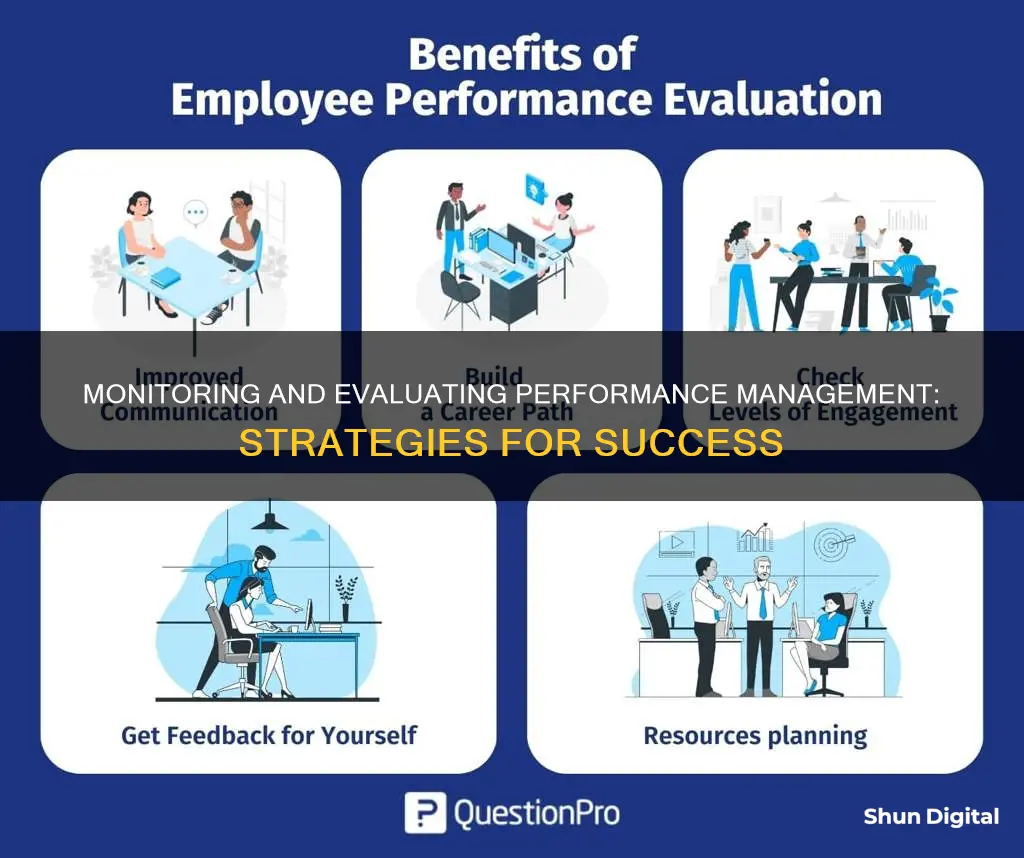
Performance management is a tool that helps managers monitor and evaluate employees' work. It is a collaborative, communication-based process where employees and management work together to plan, monitor and review the employee’s objectives, long-term goals, job trajectory and comprehensive contribution to the company. This process is continuous, with regular sessions where both management and employees have the opportunity to give and receive feedback. The steps in the performance management process can be broken down into four broad categories: Planning, coaching, reviewing and rewarding.
| Characteristics | Values |
|---|---|
| Nature | Continuous communication and feedback between managers and employees |
| Purpose | To achieve organisational objectives |
| Frequency | Continuous |
| Scope | Includes organisational, team and individual goals |
| Approach | Forward-looking, proactive, collaborative |
| Tools | SMART goals, performance management software, KPIs, performance dashboards |
What You'll Learn

Continuous monitoring and feedback
Regular Check-Ins
Regular check-ins between managers and employees are a cornerstone of continuous performance management. These meetings, often held monthly, provide a structured forum to discuss progress, address challenges, and set short-term goals. They help employees stay focused and on track to meet their objectives. Regular check-ins also facilitate open communication, fostering a culture of transparency and trust.
Ongoing Feedback
In contrast to traditional annual appraisals, continuous performance management emphasises ongoing feedback, delivered in real-time or as close to events as possible. This includes feedback from managers, peers, and even customers, known as 360-degree feedback. By providing frequent feedback, managers can identify development areas earlier, offer timely guidance, and track progress more frequently, making employee growth and skill-building a core part of the performance process.
Dynamic Goal-Setting
Goals in a continuous performance management system are flexible and adaptable. They are adjusted as projects evolve and business priorities shift, allowing employees to stay aligned with the dynamic objectives of the organisation. This agility helps employees focus on what matters most and ensures that their goals remain relevant and achievable.
Employee Self-Assessment and Reflection
Continuous performance management often encourages employees to engage in self-assessment and reflection. By evaluating their performance and progress, employees take ownership of their development and gain a clearer understanding of their strengths and areas for improvement. This self-assessment fosters a sense of accountability and empowers employees to take an active role in their professional growth.
Benefits of Continuous Monitoring and Feedback
The implementation of continuous monitoring and feedback offers a range of advantages for both employees and the organisation:
- Enhanced Employee Engagement: Regular feedback and discussions make employees feel heard, valued, and motivated. This, in turn, boosts morale, job satisfaction, and productivity.
- Improved Retention: Continuous performance management helps organisations retain top talent by fostering a culture of support and development.
- Real-time Insights and Development: With ongoing feedback, managers can provide immediate guidance, enabling employees to adjust and improve their performance promptly. This also helps managers identify barriers and provide support to prevent issues from escalating.
- Stronger Manager-Employee Relationships: Regular interactions build stronger, more trusting relationships between managers and their teams, creating a positive work environment.
- Data-Driven Decisions: Continuous monitoring and feedback generate a wealth of data that can inform decisions about training needs, promotions, and other HR-related actions. This data helps reduce bias and improves the quality of managerial choices regarding employee development and rewards.
- Personalised Employee Growth: Managers can tailor development plans to the unique needs and career aspirations of each employee, facilitating their growth and success.
- Reduced Stress and Anxiety: The frequent interactions and ongoing feedback of continuous performance management reduce the pressure and anxiety typically associated with annual performance evaluations.
Internal Fetal Monitoring: When to Remove and Why
You may want to see also

Performance management software
The software helps managers set goals and objectives, track progress and give feedback. It also facilitates ongoing communication between employees and managers, allowing for continuous feedback and performance discussions. This can be done through in-built chat features, or by integrating with commonly used communication platforms such as Slack, Microsoft Teams, or Google Workspace.
Additionally, the software can provide analytics and reporting tools to track an employee's progress toward their goals, and provide insights to managers to support their employees' individual needs.
Some examples of performance management software include:
- BambooHR: This software helps HR departments create accurate reviews based on employee answers, and allows managers to view employee progress reports and provide feedback.
- PerformYard: This software is designed to make HR processes easier through formal evaluation and reporting, and allows employees to manage and track their daily, weekly and monthly goals.
- Trakstar: This software is highly trusted by HR and managers to evaluate employees, and helps keep employees engaged and on top of their goals.
- Leapsome: This is an all-in-one performance management and employee engagement tool that helps organisations enhance their management processes. It includes features such as 360-degree reviews, employee engagement surveys, and meeting management.
- Bob: This software offers greater transparency and visibility for businesses, and provides managers with the information they need to make better decisions and lead more efficiently. It includes features such as 360-degree performance evaluations, goal setting and tracking, and automatic check-ins.
Coinbase and Your Privacy: What You Need to Know
You may want to see also

Performance improvement plans
PIPs should be a collaborative and transparent process, with managers offering solutions and support to employees. They should include:
- An assessment of an employee's current and past performance
- Clear, measurable goals with defined timeframes
- Disciplinary actions and consequences if goals are not met
- Resources, training and coaching to help the employee
- Regular meetings and check-ins
- Plans for next steps, including positive and negative outcomes
PIPs are beneficial because they promote a positive company culture, help employees feel cared for, and save time and resources by reducing the need to hire and onboard new employees. However, they can also be time-consuming and stressful for employees, and may be seen as a precursor to dismissal.
To create an effective PIP, managers should involve the employee in the process, inviting them to collaborate on performance goals and give feedback. Managers should also involve other departments, such as HR and legal, to guide and partner with them.
Overall, when used correctly, PIPs can be a valuable tool to help employees understand their shortcomings and set goals for improvement.
Best Places to Buy Compact Side Monitors
You may want to see also

Regular meetings
The frequency of these meetings can vary, but it is generally recommended to have them at least quarterly, with monthly meetings being ideal. These meetings should be structured as two-way conversations where both parties have the opportunity to provide and receive feedback. This approach fosters a culture of open and transparent communication, which is essential for effective performance management.
During these meetings, managers should focus on providing solutions and coaching opportunities rather than punitive measures for underperformance. This positive approach encourages employees to be honest about their challenges and seek guidance where needed. It also reinforces the idea that managers are invested in their employees' growth and development.
Additionally, regular meetings can be utilised to review and adjust objectives as necessary. This flexibility is crucial as it recognises that plans may need to change based on evolving circumstances or new information. By regularly evaluating goals, managers can ensure that employees remain on track and aligned with the organisation's overall objectives.
Furthermore, these meetings can be a forum for discussing performance metrics and progress towards key indicators such as sales targets, quotas, or daily activity metrics. This data-driven approach helps employees understand their contributions and how they fit into the broader context of the organisation's goals.
Finally, regular meetings can also be an opportunity to discuss development plans and career growth. By creating a safe and supportive environment, managers can work collaboratively with employees to set achievable goals, provide necessary training, and offer recognition for achievements.
In conclusion, regular meetings are a cornerstone of effective performance management. They facilitate open communication, feedback, goal-setting, and employee development, ultimately contributing to improved performance and a more engaged and motivated workforce.
Choosing the Right Wide Monitor: Measure for Best Experience
You may want to see also

Performance measurement vs. performance management
Performance measurement and performance management are distinct strategic practices with complementary roles in an organization's development.
Performance Measurement
Performance measurement deals with quantitative indicators that track the progress of a strategy. These indicators can be financial, customer-based, process-based, or people-based. Financial measures, for instance, provide a general picture of the business's health, while customer measures assess satisfaction and experience. Process measures evaluate sales processes, and people measures assess teamwork, management, and supervision. Performance measurement is a backward-looking process that answers the question, "How do we track the progress of the strategy we've put in place?"
Performance Management
Performance management, on the other hand, is a forward-looking process that focuses on setting goals and regularly checking progress toward achieving them. It asks, "How do we manage the strategy we've put in place?" This process requires leadership teams to meet regularly, discuss results, and determine actions to improve outcomes. Performance management is about taking responsibility for initiatives and driving the company forward through accountability.
Differences and Links
Performance measurement and performance management are linked, as the former provides data and indicators, while the latter uses these to evaluate, respond to, and align strategies. Performance measurement is a necessary first step, but it is not sufficient on its own. Performance management builds on this by offering ways to act on the measures and improve results.
Transitioning from Performance Measurement to Performance Management
This transition can be achieved through five key steps:
- Gaining leadership team buy-in and assigning a "champion" to promote the process.
- Integrating performance management discussions into existing meeting schedules.
- Aligning budgeting procedures with performance measures, ensuring financial support for critical goals.
- Communicating key performance indicators to the team and seeking team input on achieving these goals.
- Ensuring that HR recruits individuals whose personal objectives align with the organization's performance measures.
By following these steps, organizations can evolve from simply measuring performance to actively managing and improving it.
Monitor Height: A Quick Guide to Eye-Level Screens
You may want to see also
Frequently asked questions
Performance management is a tool that helps managers monitor, evaluate and improve employee performance. It involves setting goals, providing feedback, and offering guidance to help employees succeed and meet the organisation's objectives.
The performance management process can be broken down into four broad categories: Planning, Coaching, Reviewing, and Rewarding. Planning involves defining the job, goals, and objectives. Coaching includes regular meetings, training, and feedback sessions. Reviewing entails evaluating employee performance and the effectiveness of the process. Rewarding recognises and rewards employees for their achievements.
Technology, such as performance management software, can streamline the performance management process by providing real-time data and automated solutions. It can facilitate continuous monitoring, instant feedback, and periodic employee ratings. Additionally, it can help track goals, manage employee records, and provide a platform for ongoing feedback and coaching.
Performance management can be improved by involving employees in goal setting, providing actionable and frequent feedback, and creating a culture of open and transparent communication. It is essential to have well-defined goals, clear performance standards, and regular check-ins to address issues and keep employees on track.







